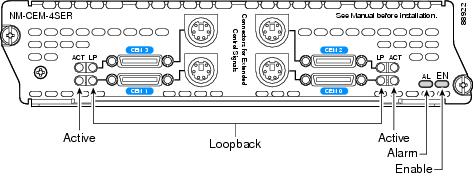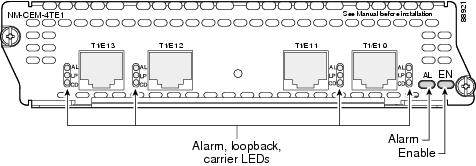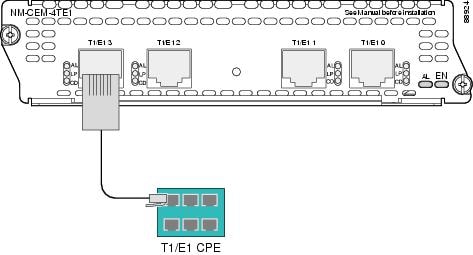CEoIP Network Modules
Available Languages
Table Of Contents
Connecting Cisco CEoIP Network Modules to the Network
4-Port Serial Interface Network Modules (NM-CEM-4SER)
4-Port Serial Interface Network Module (NM-CEM-4SER) LEDs
Connecting 4-Port Serial Interface Network Modules to the Network
Serial Interface Data Rates and Distance Limitations
Using Cisco 12-in-1 Interface Cables with the 4-Port Serial Interface Network Module (NM-CEM-4SER)
4-Port T1/E1 RJ-48 Interface Network Modules (NM-CEM-4TE1)
4-Port T1/E1 RJ-48 Interface Network Module (NM-CEM-4TE1) LEDs
Connecting 4-Port T1/E1 RJ-48 Interface Network Modules (NM-CEM-4TE1) to the Network
Obtaining Documentation, Obtaining Support, and Security Guidelines
Connecting Cisco CEoIP Network Modules to the Network
Revised: May 1, 2008, OL-12829-01
This guide describes how to connect Cisco Circuit Emulation Over IP (CEoIP) network modules to your network. It contains the following sections:
•
4-Port Serial Interface Network Modules (NM-CEM-4SER)
•
Connecting 4-Port Serial Interface Network Modules to the Network
•
4-Port T1/E1 RJ-48 Interface Network Modules (NM-CEM-4TE1)
•
Connecting 4-Port T1/E1 RJ-48 Interface Network Modules (NM-CEM-4TE1) to the Network
•
Obtaining Documentation, Obtaining Support, and Security Guidelines
Cisco CEoIP Network Modules
Cisco CEoIP network modules provide a virtual circuit through an IP network (similar to a leased line). Transport of data, regardless of the content or structure of the data stream, is entirely transparent to the destination; bits arriving at one end are delivered unchanged to the destination address.
This chapter provides information on the following two Cisco CEoIP network modules:
•
4-port serial interface network module (NM-CEM-4SER), shown in Figure 1
•
4-port T1/E1 RJ-48 interface network module (NM-CEM-4TE1), shown in Figure 2
Figure 1 4-Port Serial Interface Network Module (NM-CEM-4SER) Faceplate

Figure 2 4-Port T1/E1 RJ-48 Interface Network Module (NM-CEM-4TE 1) Faceplate

4-Port Serial Interface Network Modules (NM-CEM-4SER)
The 4-port serial interface network module (NM-CEM-4SER) is a single-wide CEoIP network module with four serial ports that support the following interfaces:
•
EIA/TIA-232
•
EIA/TIA-449
•
EIA-530
•
EIA-530A
•
V.35
•
X.21

CautionTo comply with the Telcordia GR-1089 NEBS standard for electromagnetic compatibility and safety, connect the 4-port serial interface network module (NM-CEM-4SER) only to intrabuilding or nonexposed wiring or cabling. The intrabuilding cable must be shielded and the shield must be grounded at both ends.
The interface type provided by the port is determined by the cable connected to the port. For information on interface-specific cabling requirements, see the "Connecting 4-Port Serial Interface Network Modules to the Network" section.
For information on network module LEDs, see the "4-Port Serial Interface Network Module (NM-CEM-4SER) LEDs" section.
4-Port Serial Interface Network Module (NM-CEM-4SER) LEDs
See Figure 3 for the location of network module LEDs and Table 1 for LED descriptions.
Figure 3 4-Port Serial Interface Network Module (NM-CEM-4SER) LEDs

Connecting 4-Port Serial Interface Network Modules to the Network
The 4-port serial interface network module uses Smart Serial connectors, permitting each port to support a basic or extended set of serial control signals, depending on the cable connected to the port.

CautionTo comply with the Telcordia GR-1089 NEBS standard for electromagnetic compatibility and safety, connect the 4-port serial interface network module (NM-CEM-4SER) only to intrabuilding or nonexposed wiring or cabling. The intrabuilding cable must be shielded and the shield must be grounded at both ends.
The following basic set of control signals is used on Cisco 12-in-1 cables:
•
Data Terminal Ready (DTR)
•
Data Set Ready (DSR)
•
Request to Send (RTS)
•
Clear to Send (CTS)
•
Data Carrier Detect (DCD)
•
Local Loop (LL)
The following control signals are part of the extended set, in addition to the basic set listed above, and are used on Cisco Extended 12-in-1 cables:
•
Remote Loop (RL)
•
Test Mode (TM)
•
Ring Indicator (RI)

Note
Control signal support depends on the interface type. Not all of the control signals listed above are supported by every interface type.

Note
The control signal names used in this document are the names commonly used in the industry for RS-232. Other interface types may use other names for the equivalent control signals.
The 4-port serial interface network module (NM-CEM-4SER) supports both Cisco 12-in-1 interface cables and Cisco Extended 12-in-1 interface cables with user-defined end-connectors permitting connection to either DTE or DCE interfaces.
Interfaces and DTE or DCE modes are defined by the type of cable connected to the network module.

Tip
Use the Cisco 12-in-1 cable for X.21 interfaces. The X.21 interface connector does not require an additional DIN connector.
For information on using Cisco 12-in-1 cables with the 4-port serial interface network module, see Table 3. Figure 4 illustrates how to connect the Cisco 12-in-1 cable to the network module.
For information on using Cisco Extended 12-in-1 cables with the 4-port serial interface network module, see Table 4. Figure 5 illustrates how to connect the Cisco Extended 12-in-1 cable to the network module.
All serial interface types are available in DTE or DCE format: DTE requires a plug connector at the customer premises equipment (CPE) end, and DCE requires a receptacle connector at the CPE end.
Serial Interface Data Rates and Distance Limitations
All serial signals are subject to distance limits, beyond which the signal degrades significantly or is completely lost. Generally, the slower the data rate, the greater the distance the signal can travel.
Table 2 lists maximum recommended speeds and distances for each serial interface type. If you understand and compensate for potential electrical problems, you may get good results at speeds and distances greater than those listed. For instance, the recommended maximum rate for V.35 is 2 Mbps, but 4 Mbps is commonly used.
Balanced drivers allow EIA/TIA-449, EIA/TIA-530, EIA/TIA-530A, V.35, and X.21 signals to travel greater distances than EIA/TIA-232 signals. All balanced interfaces easily support 4 to 8 Mbps.
Using Cisco 12-in-1 Interface Cables with the 4-Port Serial Interface Network Module (NM-CEM-4SER)
Table 3 lists the Cisco 12-in-1 interface cables supported by the 4-port serial interface network module. Use the cable part number to order replacement or spare cables for the interface and DTE or DCE mode appropriate for your network.
Figure 4 illustrates how to connect the Cisco 12-in-1 cable to the network module.
Figure 4 Connecting the Cisco 12-in-1 Interface Cable to the 4-Port Serial Interface Network Module (NM-CEM-4SER)

Using Cisco Extended 12-in-1 Interface Cables with the 4-Port Serial Interface Network Module (NM-CEM-4SER)
Table 4 lists the Cisco Extended 12-in-1 interface cables supported by the 4-port serial interface network module. Use the cable part number to order replacement or spare cables for the interface and DTE or DCE mode appropriate for your network.
Figure 5 illustrates how to connect the Cisco 12-in-1 cable to the network module.

Note
Cisco Extended 12-in-1 cables provide additional control signals through the DIN cable connection.
Figure 5 Connecting the Cisco Extended 12-in-1 Interface Cable to the 4-Port Serial Interface Network Module (NM-CEM-4SER)

4-Port T1/E1 RJ-48 Interface Network Modules (NM-CEM-4TE1)
The 4-port T1/E1 RJ-48 interface network module (NM-CEM-4TE1) is a single-wide CEoIP network module with four T1/E1 ports. (See Figure 2.) The NM-CEM-4TE1 connects to any T1/E1 interface for voice or data.
4-Port T1/E1 RJ-48 Interface Network Module (NM-CEM-4TE1) LEDs
See Figure 6 for the location of network module LEDs and Table 5 for LED descriptions.
Figure 6 4-Port T1/E1 RJ-48 Interface Network Module (NM-CEM-4TE1) LEDs

Connecting 4-Port T1/E1 RJ-48 Interface Network Modules (NM-CEM-4TE1) to the Network
The 4-port T1/E1 RJ-48 interface network module (NM-CEM-4TE1) uses a RJ-48 straight-through cable to connect to the customer premises equipment (CPE) for use in T1 or E1 circuit emulation. (See Figure 7.)

Note
All four ports on the network module must operate in the same software-configured mode, either as T1 ports or as E1 ports. The NM-CEM-4TE1 network module does not support combinations of T1 and E1 ports on the same network module.
When configured for E1 operation, the NM-CEM-4TE1 network module provides four 120-ohm balanced ports. To connect any of these ports to a 75-ohm unbalanced network, use Cisco cable CAB-ADP-75-120. For more information, see the Installing the 75-120-Ohm Adapter Cable on E1 Multichannel Port Adapters document:
Figure 7 Connecting the 4-Port T1/E1 RJ-48 Interface Network Module (NM-CEM-4TE1) to the Network

Related Documents
For additional information, see the following documents and resources.
Regulatory compliance and safety information
Cisco Network Modules and Interface Cards Regulatory Compliance and Safety Information
http://www.cisco.com/en/US/docs/routers/access/interfaces/rcsi/IOHrcsi.htmlCisco IOS software website and reference documentation
Cisco IOS Software
http://www.cisco.com/web/psa/products/index.html?c=268438303
Obtaining Documentation, Obtaining Support, and Security Guidelines
For information on obtaining documentation, obtaining support, providing documentation feedback, security guidelines, and also recommended aliases and general Cisco documents, see the monthly What's New in Cisco Product Documentation, which also lists all new and revised Cisco technical documentation, at:
http://www.cisco.com/en/US/docs/general/whatsnew/whatsnew.html
CCDE, CCENT, Cisco Eos, Cisco Lumin, Cisco StadiumVision, the Cisco logo, DCE, and Welcome to the Human Network are trademarks; Changing the Way We Work, Live, Play, and Learn is a service mark; and Access Registrar, Aironet, AsyncOS, Bringing the Meeting To You, Catalyst, CCDA, CCDP, CCIE, CCIP, CCNA, CCNP, CCSP, CCVP, Cisco, the Cisco Certified Internetwork Expert logo, Cisco IOS, Cisco Press, Cisco Systems, Cisco Systems Capital, the Cisco Systems logo, Cisco Unity, Collaboration Without Limitation, EtherFast, EtherSwitch, Event Center, Fast Step, Follow Me Browsing, FormShare, GigaDrive, HomeLink, Internet Quotient, IOS, iPhone, iQ Expertise, the iQ logo, iQ Net Readiness Scorecard, iQuick Study, IronPort, the IronPort logo, LightStream, Linksys, MediaTone, MeetingPlace, MGX, Networkers, Networking Academy, Network Registrar, PCNow, PIX, PowerPanels, ProConnect, ScriptShare, SenderBase, SMARTnet, Spectrum Expert, StackWise, The Fastest Way to Increase Your Internet Quotient, TransPath, WebEx, and the WebEx logo are registered trademarks of Cisco Systems, Inc. and/or its affiliates in the United States and certain other countries.
All other trademarks mentioned in this document or Website are the property of their respective owners. The use of the word partner does not imply a partnership relationship between Cisco and any other company. (0804R)
Any Internet Protocol (IP) addresses used in this document are not intended to be actual addresses. Any examples, command display output, and figures included in the document are shown for illustrative purposes only. Any use of actual IP addresses in illustrative content is unintentional and coincidental.
© 2008 Cisco Systems, Inc. All rights reserved.
Contact Cisco
- Open a Support Case

- (Requires a Cisco Service Contract)
 Feedback
Feedback